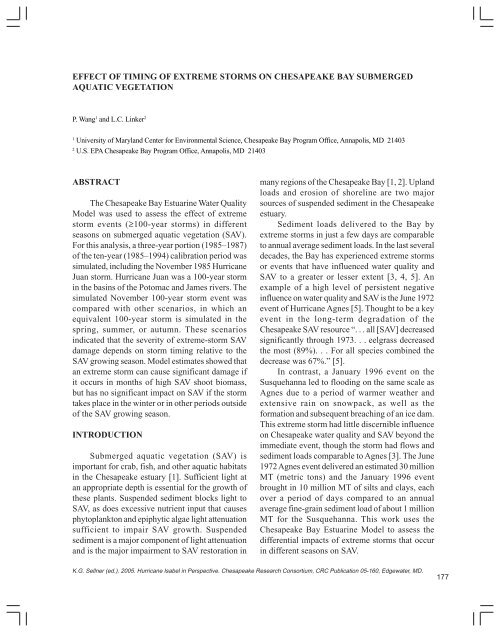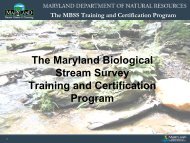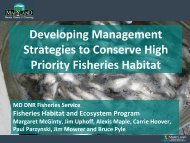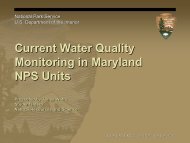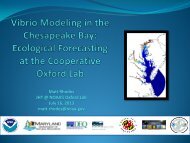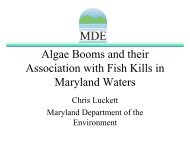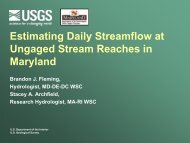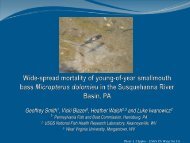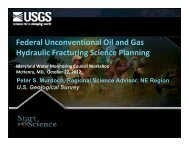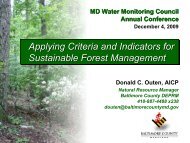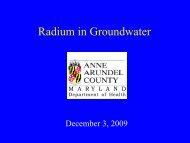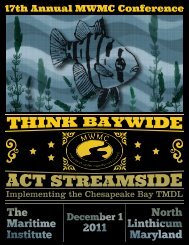Effect of Timing of Extreme Storms on Chesapeake - Maryland ...
Effect of Timing of Extreme Storms on Chesapeake - Maryland ...
Effect of Timing of Extreme Storms on Chesapeake - Maryland ...
Create successful ePaper yourself
Turn your PDF publications into a flip-book with our unique Google optimized e-Paper software.
EFFECT OF TIMING OF EXTREME STORMS ON CHESAPEAKE BAY SUBMERGED<br />
AQUATIC VEGETATION<br />
P. Wang 1 and L.C. Linker 2<br />
1 University <str<strong>on</strong>g>of</str<strong>on</strong>g> <strong>Maryland</strong> Center for Envir<strong>on</strong>mental Science, <strong>Chesapeake</strong> Bay Program Office, Annapolis, MD 21403<br />
2 U.S. EPA <strong>Chesapeake</strong> Bay Program Office, Annapolis, MD 21403<br />
ABSTRACT<br />
The <strong>Chesapeake</strong> Bay Estuarine Water Quality<br />
Model was used to assess the effect <str<strong>on</strong>g>of</str<strong>on</strong>g> extreme<br />
storm events (≥100-year storms) in different<br />
seas<strong>on</strong>s <strong>on</strong> submerged aquatic vegetati<strong>on</strong> (SAV).<br />
For this analysis, a three-year porti<strong>on</strong> (1985–1987)<br />
<str<strong>on</strong>g>of</str<strong>on</strong>g> the ten-year (1985–1994) calibrati<strong>on</strong> period was<br />
simulated, including the November 1985 Hurricane<br />
Juan storm. Hurricane Juan was a 100-year storm<br />
in the basins <str<strong>on</strong>g>of</str<strong>on</strong>g> the Potomac and James rivers. The<br />
simulated November 100-year storm event was<br />
compared with other scenarios, in which an<br />
equivalent 100-year storm is simulated in the<br />
spring, summer, or autumn. These scenarios<br />
indicated that the severity <str<strong>on</strong>g>of</str<strong>on</strong>g> extreme-storm SAV<br />
damage depends <strong>on</strong> storm timing relative to the<br />
SAV growing seas<strong>on</strong>. Model estimates showed that<br />
an extreme storm can cause significant damage if<br />
it occurs in m<strong>on</strong>ths <str<strong>on</strong>g>of</str<strong>on</strong>g> high SAV shoot biomass,<br />
but has no significant impact <strong>on</strong> SAV if the storm<br />
takes place in the winter or in other periods outside<br />
<str<strong>on</strong>g>of</str<strong>on</strong>g> the SAV growing seas<strong>on</strong>.<br />
INTRODUCTION<br />
Submerged aquatic vegetati<strong>on</strong> (SAV) is<br />
important for crab, fish, and other aquatic habitats<br />
in the <strong>Chesapeake</strong> estuary [1]. Sufficient light at<br />
an appropriate depth is essential for the growth <str<strong>on</strong>g>of</str<strong>on</strong>g><br />
these plants. Suspended sediment blocks light to<br />
SAV, as does excessive nutrient input that causes<br />
phytoplankt<strong>on</strong> and epiphytic algae light attenuati<strong>on</strong><br />
sufficient to impair SAV growth. Suspended<br />
sediment is a major comp<strong>on</strong>ent <str<strong>on</strong>g>of</str<strong>on</strong>g> light attenuati<strong>on</strong><br />
and is the major impairment to SAV restorati<strong>on</strong> in<br />
many regi<strong>on</strong>s <str<strong>on</strong>g>of</str<strong>on</strong>g> the <strong>Chesapeake</strong> Bay [1, 2]. Upland<br />
loads and erosi<strong>on</strong> <str<strong>on</strong>g>of</str<strong>on</strong>g> shoreline are two major<br />
sources <str<strong>on</strong>g>of</str<strong>on</strong>g> suspended sediment in the <strong>Chesapeake</strong><br />
estuary.<br />
Sediment loads delivered to the Bay by<br />
extreme storms in just a few days are comparable<br />
to annual average sediment loads. In the last several<br />
decades, the Bay has experienced extreme storms<br />
or events that have influenced water quality and<br />
SAV to a greater or lesser extent [3, 4, 5]. An<br />
example <str<strong>on</strong>g>of</str<strong>on</strong>g> a high level <str<strong>on</strong>g>of</str<strong>on</strong>g> persistent negative<br />
influence <strong>on</strong> water quality and SAV is the June 1972<br />
event <str<strong>on</strong>g>of</str<strong>on</strong>g> Hurricane Agnes [5]. Thought to be a key<br />
event in the l<strong>on</strong>g-term degradati<strong>on</strong> <str<strong>on</strong>g>of</str<strong>on</strong>g> the<br />
<strong>Chesapeake</strong> SAV resource “. . . all [SAV] decreased<br />
significantly through 1973. . . eelgrass decreased<br />
the most (89%). . . For all species combined the<br />
decrease was 67%.” [5].<br />
In c<strong>on</strong>trast, a January 1996 event <strong>on</strong> the<br />
Susquehanna led to flooding <strong>on</strong> the same scale as<br />
Agnes due to a period <str<strong>on</strong>g>of</str<strong>on</strong>g> warmer weather and<br />
extensive rain <strong>on</strong> snowpack, as well as the<br />
formati<strong>on</strong> and subsequent breaching <str<strong>on</strong>g>of</str<strong>on</strong>g> an ice dam.<br />
This extreme storm had little discernible influence<br />
<strong>on</strong> <strong>Chesapeake</strong> water quality and SAV bey<strong>on</strong>d the<br />
immediate event, though the storm had flows and<br />
sediment loads comparable to Agnes [3]. The June<br />
1972 Agnes event delivered an estimated 30 milli<strong>on</strong><br />
MT (metric t<strong>on</strong>s) and the January 1996 event<br />
brought in 10 milli<strong>on</strong> MT <str<strong>on</strong>g>of</str<strong>on</strong>g> silts and clays, each<br />
over a period <str<strong>on</strong>g>of</str<strong>on</strong>g> days compared to an annual<br />
average fine-grain sediment load <str<strong>on</strong>g>of</str<strong>on</strong>g> about 1 milli<strong>on</strong><br />
MT for the Susquehanna. This work uses the<br />
<strong>Chesapeake</strong> Bay Estuarine Model to assess the<br />
differential impacts <str<strong>on</strong>g>of</str<strong>on</strong>g> extreme storms that occur<br />
in different seas<strong>on</strong>s <strong>on</strong> SAV.<br />
K.G. Sellner (ed.). 2005. Hurricane Isabel in Perspective. <strong>Chesapeake</strong> Research C<strong>on</strong>sortium, CRC Publicati<strong>on</strong> 05-160, Edgewater, MD.<br />
177
178<br />
METHODS<br />
The year 2002 versi<strong>on</strong> <str<strong>on</strong>g>of</str<strong>on</strong>g> the <strong>Chesapeake</strong> Bay<br />
Estuarine Model (CBEM) [6] is used to model the<br />
resp<strong>on</strong>se <str<strong>on</strong>g>of</str<strong>on</strong>g> SAV to nutrient and sediment loads.<br />
The CBEM is a coupled three-dimensi<strong>on</strong>al<br />
Hydrodynamic Model and Water Quality Model<br />
[6, 7]. The Water Quality Model is simulated in a<br />
15-minute time step, driven by hydrodynamic<br />
forcing in a two-hour interval, with daily inputs <str<strong>on</strong>g>of</str<strong>on</strong>g><br />
n<strong>on</strong>point sources and other loads. The model was<br />
calibrated over a ten-year period (1985–1994) [6].<br />
Water quality and SAV resp<strong>on</strong>ses to flow and<br />
loads were successfully simulated by both the<br />
<strong>Chesapeake</strong> Bay Watershed Model [8] and the<br />
Water Quality Model [6] for the calibrati<strong>on</strong> period<br />
<str<strong>on</strong>g>of</str<strong>on</strong>g> 1985–1994, including Hurricane Juan, a 100year<br />
storm occurring in November 1985. The<br />
following points describe three important<br />
comp<strong>on</strong>ents <str<strong>on</strong>g>of</str<strong>on</strong>g> the model in this work.<br />
1)The Water Quality Model simulates light<br />
extincti<strong>on</strong> (K e ) due to water, dissolved organic<br />
matter (DOM) also know as “color,” volatile<br />
suspended sediment (VSS), and inorganic<br />
suspended sediment (ISS) [6, 9]:<br />
K e = a 1 + a 2 * ISS + a 3 * VSS (1)<br />
where:<br />
a 1 = background attenuati<strong>on</strong> from water and<br />
DOM<br />
a 2 = attenuati<strong>on</strong> from inorganic solids<br />
a 3 = attenuati<strong>on</strong> from organic suspended solids<br />
2)The simulated SAV producti<strong>on</strong> is light,<br />
temperature, and nutrient dependent. The<br />
SAV submodel simulates three major<br />
comp<strong>on</strong>ents: shoots, roots, and epiphytes.<br />
Producti<strong>on</strong> transformati<strong>on</strong> between shoots<br />
and roots is c<strong>on</strong>sidered. The simulated shoot<br />
reflects the above-ground abundance <str<strong>on</strong>g>of</str<strong>on</strong>g> SAV.<br />
The following equati<strong>on</strong> is shoot simulati<strong>on</strong><br />
in the SAV submodel in the CBEM [9]:<br />
d SH<br />
——— = [P - (1-Fpsr) - R - SL] SH + TrsRT (2)<br />
d t<br />
where:<br />
SH = SAV shoot biomass; (g C m -2 );<br />
t = time (d);<br />
Fpsr = fracti<strong>on</strong> <str<strong>on</strong>g>of</str<strong>on</strong>g> gross producti<strong>on</strong> routed<br />
from shoot to root;<br />
P = producti<strong>on</strong> (d -1 );<br />
R = shoot respirati<strong>on</strong> (d -1 );<br />
SL = sloughing (d -1 );<br />
Trs = rate at which carb<strong>on</strong> is transported from<br />
root to shoot (d -1 ).<br />
RT = root biomass (g C m -2 ),<br />
3) The setup <str<strong>on</strong>g>of</str<strong>on</strong>g> scenarios with a 100-year storm<br />
in different seas<strong>on</strong>s is as follows:<br />
The November storm scenario simulates the<br />
actual November, 1985 Hurricane Juan event.<br />
Although <strong>on</strong>ly a Category 1 hurricane, Juan ranks<br />
as the eighth costliest hurricane to strike the U.S.<br />
mainland. In the <strong>Chesapeake</strong>, Hurricane Juan<br />
c<strong>on</strong>stituted a 100-year storm that caused flooding<br />
primarily in the Potomac and James watersheds.<br />
The other scenarios simulate an extreme storm<br />
occurring in other m<strong>on</strong>ths, including May, July,<br />
and September in 1985, or a simulati<strong>on</strong> <str<strong>on</strong>g>of</str<strong>on</strong>g> no storm<br />
in the year 1985.<br />
Hurricane Juan hit the <strong>Chesapeake</strong> regi<strong>on</strong> <strong>on</strong><br />
3 November in 1985, and lasted for 3 days as a<br />
high rainfall event centered in the upper watersheds<br />
<str<strong>on</strong>g>of</str<strong>on</strong>g> the Potomac and James rivers. The high river<br />
flows from this rainfall event persisted for about 2<br />
weeks (Figure 1). The hydrology and n<strong>on</strong>point load<br />
<str<strong>on</strong>g>of</str<strong>on</strong>g> <strong>on</strong>e spring-neap tide cycle (about 14 and a half<br />
days) during 1–15 November in 1985 were used<br />
as the “storm input” for other scenarios. For<br />
example, the May Storm Scenario uses the<br />
equivalent “storm input” in May. In the meantime,<br />
the September low-flow c<strong>on</strong>diti<strong>on</strong> in <strong>on</strong>e springneap<br />
tide cycle was used as the “no-storm<br />
c<strong>on</strong>diti<strong>on</strong>” input during 1–15 November for the<br />
May Storm Scenario (Figure 2). The 14-and-a-halfday<br />
storm substituti<strong>on</strong> matches the cycles <str<strong>on</strong>g>of</str<strong>on</strong>g> the<br />
spring-neap tides (from the 1985 tide record) [10].<br />
Since point source load input for the Water Quality<br />
Model input is m<strong>on</strong>thly and varies <strong>on</strong>ly a trivial<br />
amount during am<strong>on</strong>g the 1985 m<strong>on</strong>ths, point<br />
source load is not adjusted for these scenarios.
Flow (1000 ft 3 ⋅sec -1 )<br />
Figure 1. Daily flow at the fall-line <str<strong>on</strong>g>of</str<strong>on</strong>g> the Potomac River (1985–1987).<br />
The CBEM is simulated for 3 years from 1985<br />
to 1987. All <str<strong>on</strong>g>of</str<strong>on</strong>g> these scenarios use the same<br />
hydrology and loading inputs in the simulati<strong>on</strong><br />
during 1986 and 1987.<br />
RESULTS AND DISCUSSION<br />
<str<strong>on</strong>g>Effect</str<strong>on</strong>g> <strong>on</strong> Water Clarity by Hurricanes<br />
In the tidal-fresh Potomac regi<strong>on</strong>, light<br />
attenuati<strong>on</strong> (K e ) increases abruptly due to the<br />
simulated 100-year storm event (Figure 3). Four<br />
light attenuati<strong>on</strong> peaks (K e near 100 m -1 ) corresp<strong>on</strong>d<br />
to the simulated May, July, September, and<br />
November storms. The light attenuati<strong>on</strong> remains<br />
12345678<br />
12345678<br />
Days Elapsed from January 1, 1985<br />
Figure 2. Example <str<strong>on</strong>g>of</str<strong>on</strong>g> the method used to simulate the Hurricane Juan event in May.<br />
high (K e >4 m -1 ) for weeks after the storm, most<br />
significantly (e.g., K e >8 m -1 ) in the first week after<br />
the storm. The graph’s open circle symbol denotes<br />
the No-Storm Scenario, which has no extreme high<br />
peaks in light attenuati<strong>on</strong>. However, K e in many<br />
days is higher than the optimal level to SAV<br />
communities (tidal-fresh SAV, K e
180<br />
Ke (m -1 )<br />
Days Elapsed since January 1, 1985<br />
Figure 3. Ke in the Potomac tidal fresh regi<strong>on</strong> for five scenarios.<br />
TSS (mg⋅L -1 )<br />
Figure 4. TSS in the Potomac tidal fresh regi<strong>on</strong> for five scenarios.<br />
due to inorganic suspended solids, for the different<br />
scenarios.<br />
<str<strong>on</strong>g>Effect</str<strong>on</strong>g> <str<strong>on</strong>g>of</str<strong>on</strong>g> <str<strong>on</strong>g>Extreme</str<strong>on</strong>g> <str<strong>on</strong>g>Storms</str<strong>on</strong>g> in<br />
Different Seas<strong>on</strong>s <strong>on</strong> SAV<br />
Tidal-Fresh Regi<strong>on</strong>s<br />
Figure 5 and Figure 6 are simulated m<strong>on</strong>thly<br />
SAV biomass from 1985 to 1987 in the Potomac<br />
and James rivers’ tidal-fresh regi<strong>on</strong>s. Generally, the<br />
shoot biomass <str<strong>on</strong>g>of</str<strong>on</strong>g> the tidal-fresh SAV community<br />
peaks during September and October with a<br />
prominent growing seas<strong>on</strong> <str<strong>on</strong>g>of</str<strong>on</strong>g> shoot biomass from<br />
May to November (Figure 7) [9, 11]. The tidal-<br />
Days Elapsed since January 1, 1985<br />
fresh SAV community is simulated in both the<br />
Potomac and James tidal-fresh regi<strong>on</strong>s (Figures 5<br />
and 6).<br />
The Potomac and James tidal-fresh (Figures<br />
5 and 6), SAV biomass was decremented in the first<br />
year by the simulated May, July, and September<br />
extreme storm. The November extreme storm has<br />
no more effect than the No-Storm Scenario. After<br />
the peak in September, SAV growth follows the<br />
natural decline <str<strong>on</strong>g>of</str<strong>on</strong>g> shoots toward winter; therefore,<br />
the resp<strong>on</strong>se <str<strong>on</strong>g>of</str<strong>on</strong>g> SAV to a post-peak storm is less<br />
than the resp<strong>on</strong>se <str<strong>on</strong>g>of</str<strong>on</strong>g> SAV to a storm during or before<br />
the peak.
SAV biomass was also affected in the sec<strong>on</strong>d<br />
year in the May, July, and September scenarios and<br />
again the effects <str<strong>on</strong>g>of</str<strong>on</strong>g> the November storm were<br />
indiscernible from the No-Storm Scenario (Figures<br />
5 and 6). The sec<strong>on</strong>d-year influence <str<strong>on</strong>g>of</str<strong>on</strong>g> the May,<br />
July, and September scenarios probably results<br />
from decreases in simulated overwintering SAV<br />
root due to the Fpsr and Tsr terms in Equati<strong>on</strong> 2.<br />
This decrease suggests that lower shoot<br />
survival during the winter due to the effect <str<strong>on</strong>g>of</str<strong>on</strong>g> storm<br />
before winter results in the apparent lower biomass<br />
in the following year for the corresp<strong>on</strong>ding storm<br />
scenario.<br />
SAV Biomass (t<strong>on</strong>s) SAV Biomass (t<strong>on</strong>s)<br />
Figure 5. SAV biomass in the Potomac tidal fresh regi<strong>on</strong> for five scenarios.<br />
Figure 6. SAV biomass in the James tidal fresh regi<strong>on</strong> for five scenarios.<br />
Polyhaline Regi<strong>on</strong><br />
Figure 8 shows simulated m<strong>on</strong>thly SAV<br />
biomass from 1985 to 1987 in the lower estuary<br />
polyhaline James River. The polyhaline SAV<br />
community peaks in July and again in October, with<br />
a prominent growing seas<strong>on</strong> <str<strong>on</strong>g>of</str<strong>on</strong>g> shoot biomass<br />
occurring from April to November [9, 11], as shown<br />
in Figure 9.<br />
In the James lower estuary polyhaline regi<strong>on</strong>,<br />
simulated SAV shoot biomass is decreased by the<br />
May, July, and September simulated extreme-storm<br />
events but not by the November simulated extreme<br />
storm (Figure 8). In this storm, the simulati<strong>on</strong> <str<strong>on</strong>g>of</str<strong>on</strong>g><br />
M<strong>on</strong>ths Elapsed since January 1, 1985<br />
M<strong>on</strong>ths Elapsed since January 1, 1985<br />
181
182<br />
Figure 7. Simulated and observed SAV shoot biomass for a tidal fresh SAV community. Modeled (mean [solid line]<br />
and interval encompassing 95% <str<strong>on</strong>g>of</str<strong>on</strong>g> computati<strong>on</strong>s [dashed line]) and observed (mean [dot] and 95% c<strong>on</strong>fidence<br />
interval [vertical line through dot]) freshwater SAV community (above-ground shoot biomass <strong>on</strong>ly). Observati<strong>on</strong>s<br />
from Moore et al. [11]. Model simulati<strong>on</strong> from the Susquehanna Flats (Segment CB1TF) using the 10,000-cell<br />
1998 versi<strong>on</strong> <str<strong>on</strong>g>of</str<strong>on</strong>g> the Water Quality Model. Source: Cerco et al. [9].<br />
SAV Biomass (t<strong>on</strong>s)<br />
SAV Shoot Biomass<br />
(g C⋅m-2 )<br />
Figure 8. SAV biomass in the James lower estuary regi<strong>on</strong> for five scenarios.<br />
the first year’s effects is the same in the tidal-fresh<br />
and polyhaline SAV communities. A difference<br />
occurs in the sec<strong>on</strong>d year when the simulated<br />
polyhaline SAV shoot biomass is influenced by the<br />
November extreme storm.<br />
In all cases, by the third year the effect <str<strong>on</strong>g>of</str<strong>on</strong>g><br />
simulated extreme storm events <strong>on</strong> SAV shoot<br />
biomass is unobserved.<br />
M<strong>on</strong>th<br />
M<strong>on</strong>ths Elapsed since January 1, 1985<br />
CONCLUSIONS<br />
Based <strong>on</strong> the model scenarios, the following<br />
c<strong>on</strong>clusi<strong>on</strong>s were reached:<br />
• <str<strong>on</strong>g>Extreme</str<strong>on</strong>g> events, such as hurricanes, deliver<br />
high sediment loads and reduce clarity below<br />
that level required to support SAV, <str<strong>on</strong>g>of</str<strong>on</strong>g>ten over<br />
a period <str<strong>on</strong>g>of</str<strong>on</strong>g> weeks.
SAV Shoot Biomass<br />
(g C⋅m-2 )<br />
• <str<strong>on</strong>g>Extreme</str<strong>on</strong>g> storm events during the SAV<br />
growing seas<strong>on</strong> are detrimental, particularly<br />
during periods before peak shoot biomass.<br />
• <str<strong>on</strong>g>Extreme</str<strong>on</strong>g> storms during the SAV growing<br />
seas<strong>on</strong>, but after the shoot biomass peak, are<br />
estimated to be less detrimental. In the<br />
simulated tidal-fresh SAV community, the<br />
November extreme event has no effect <strong>on</strong><br />
SAV shoot biomass as the shoot biomass<br />
during this time is already in a normal, natural<br />
decline leading to an absence <str<strong>on</strong>g>of</str<strong>on</strong>g> SAV shoot<br />
biomass by December.<br />
• In tidal-fresh SAV communities, the degree<br />
<str<strong>on</strong>g>of</str<strong>on</strong>g> diminuti<strong>on</strong> <str<strong>on</strong>g>of</str<strong>on</strong>g> SAV shoot biomass carries<br />
over as an “echo” <str<strong>on</strong>g>of</str<strong>on</strong>g> decreased SAV biomass<br />
in the sec<strong>on</strong>d year. This effect is due to the<br />
decrease in simulated shoot biomass carried<br />
forward by a decrease in simulated shoot<br />
biomass. By the third simulated year <str<strong>on</strong>g>of</str<strong>on</strong>g> SAV<br />
resp<strong>on</strong>se, the effect <str<strong>on</strong>g>of</str<strong>on</strong>g> extreme storms <strong>on</strong> SAV<br />
biomass is generally unobserved.<br />
• In the simulated polyhaline James SAV<br />
community, the SAV resp<strong>on</strong>se to extreme<br />
storms was similar to that <str<strong>on</strong>g>of</str<strong>on</strong>g> the tidal fresh<br />
with the excepti<strong>on</strong> <str<strong>on</strong>g>of</str<strong>on</strong>g> the November storm.<br />
In this case, the simulated November storm<br />
M<strong>on</strong>th<br />
Figure 9. Simulated and observed SAV shoot biomass for a polyhaline SAV community. Modeled (mean [solid<br />
line] and interval encompassing 95% <str<strong>on</strong>g>of</str<strong>on</strong>g> computati<strong>on</strong>s [dashed line]) and observed (mean [dot] and 95% c<strong>on</strong>fidence<br />
interval [vertical line through dot]) polyhaline SAV community (Zostera above-ground shoot biomass <strong>on</strong>ly).<br />
Observati<strong>on</strong>s from Moore et al. [11]. Model simulati<strong>on</strong> from Mobjack Bay (segment MOBPH, formerly WE4) using<br />
the 10,000-cell 1998 versi<strong>on</strong> <str<strong>on</strong>g>of</str<strong>on</strong>g> the <strong>Chesapeake</strong> Bay Water Quality Model. Source: Cerco et al. [9].<br />
is close to the sec<strong>on</strong>dary October peak in the<br />
polyhaline SAV community shoot biomass.<br />
The resulting decreased SAV shoot biomass<br />
in November carried over to a noticeable SAV<br />
decrease during the sec<strong>on</strong>d year.<br />
• <str<strong>on</strong>g>Timing</str<strong>on</strong>g> <str<strong>on</strong>g>of</str<strong>on</strong>g> storms relative to SAV growing<br />
seas<strong>on</strong>s causes different effects <strong>on</strong> SAV,<br />
c<strong>on</strong>sistent with the observati<strong>on</strong>s noted in the<br />
introducti<strong>on</strong> [3, 4, 5], though the model does<br />
not directly simulate some <str<strong>on</strong>g>of</str<strong>on</strong>g> these storms.<br />
REFERENCES<br />
1. R.A. Batiuk, P. Bergstrom, M. Kemp, and<br />
others. 2000. In: <strong>Chesapeake</strong> Bay Submerged<br />
Aquatic Vegetati<strong>on</strong> Water Quality, Habitat-<br />
Based Requirements, and Restorati<strong>on</strong> Targets:<br />
A Sec<strong>on</strong>d Technical Synthesis. USEPA<br />
<strong>Chesapeake</strong> Bay Program, Annapolis, MD. 217<br />
pp.<br />
2. L.C. Gallegos. 2001. Calculating optical water<br />
quality targets to restore and protect submersed<br />
aquatic vegetati<strong>on</strong>: Overcoming problems in<br />
partiti<strong>on</strong>ing the diffuse attenuati<strong>on</strong> coefficient<br />
for photosynthetically active radiati<strong>on</strong>.<br />
Estuaries 24: 381–397.<br />
183
184<br />
3. Virginia Institute <str<strong>on</strong>g>of</str<strong>on</strong>g> Marine Science. 2004. SAV<br />
areas in <strong>Chesapeake</strong> Bay by CBP segments<br />
(1971–2001). www.vims.edu.<br />
4. Virginia Institute <str<strong>on</strong>g>of</str<strong>on</strong>g> Marine Science. 2004. 2003<br />
field observati<strong>on</strong>s and a first look at the aerial<br />
photography. www.vims.edu.<br />
5. E.P. Ruzecki and others (eds.). 1976. The <str<strong>on</strong>g>Effect</str<strong>on</strong>g><br />
<str<strong>on</strong>g>of</str<strong>on</strong>g> Tropical Storm Agnes <strong>on</strong> the <strong>Chesapeake</strong> Bay<br />
Estuarine System. <strong>Chesapeake</strong> Bay Research<br />
C<strong>on</strong>sortium Publicati<strong>on</strong> No. 54. Johns Hopkins<br />
University Press. Baltimore, MD.<br />
6. C.F. Cerco and M.R. Noel. 2004. The 2002<br />
<strong>Chesapeake</strong> Bay eutrophicati<strong>on</strong> model,<br />
Prepared for <strong>Chesapeake</strong> Bay Program Office,<br />
Annapolis, MD. EPA 903-R-04-004. p. 349.<br />
7. C.F. Cerco and T.M. Cole. 1993. Threedimensi<strong>on</strong>al<br />
eutrophicati<strong>on</strong> model <str<strong>on</strong>g>of</str<strong>on</strong>g> the<br />
<strong>Chesapeake</strong> Bay. J. Envir. Eng. 119(6): 1006–<br />
1025.<br />
8. L.C. Linker, G.W. Shenk, P. Wang, and J.M.<br />
Storrick. 1998. <strong>Chesapeake</strong> Bay Watershed<br />
Model Applicati<strong>on</strong> & Calculati<strong>on</strong> <str<strong>on</strong>g>of</str<strong>on</strong>g> Nutrient<br />
& Sediment Loading, Appendix B. EPA903-<br />
R-98-003, CBP/TRS 196/98. p. 641.<br />
9. C.F. Cerco, B.H. Johns<strong>on</strong>, and H.W. Wang.<br />
2002. Tributary Refinements to the <strong>Chesapeake</strong><br />
Bay Model. Report ERDC TR-02-4. U.S. Army<br />
Corps <str<strong>on</strong>g>of</str<strong>on</strong>g> Engineers, Washingt<strong>on</strong>, D.C.<br />
10. Virginia Institute <str<strong>on</strong>g>of</str<strong>on</strong>g> Marine Science. 2004.<br />
Historical tide data. www.vims.edu./resources/<br />
databases.html#tide<br />
11. K.A. Moore, D.J. Wilcox, and R.J. Orth. 2000.<br />
Analysis <str<strong>on</strong>g>of</str<strong>on</strong>g> abundance <str<strong>on</strong>g>of</str<strong>on</strong>g> submersed aquatic<br />
vegetati<strong>on</strong> communities in the <strong>Chesapeake</strong> Bay.<br />
Estuaries 23(1): 115–127.


